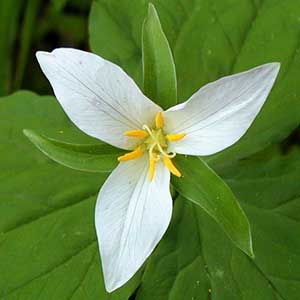Trillium ovatum
Trillium rugelii
Pacific trillium, trillium, western trillium, western wake-robin, western white trillium, white or western trillium, white trillium
illscented wakerobin, southern nodding trillium
semierect to horizontal, short, stout, praemorse.
short, thick, tapered to point distally.
1–2, round, 2–5 dm, ± slender, glabrous.
1–3, round in cross section, 1.5–4 dm, robust, glabrous.
sessile, subsessile, or short-petiolate;
blade medium green, sometimes blotched and mottled, main veins prominent, ovate-rhombic, 7–12 × 5–20 cm, continuing to expand during anthesis, base rounded, apex acuminate.
sessile to subsessile;
blade bright green, veins not engraved, rhombic, broader than long, 6–15 × 6–16 cm, not glossy, base attenuate, apex acuminate.
erect or nodding, odorless;
sepals spreading to horizontal, green, lanceolate to oblong-lanceolate, 15–50 × 6–20 mm, margins entire, apex acute;
petals erect-ascending, usually wide-spreading from base, exposing entire pistil, white or with pink or blush markings, lacking V-shaped markings, fading to rosy pink, purple, or dark red, veins not deeply engraved, ± linear to widely obovate, 1.5–7 ×1–4 cm, widest at or above middle, thin-textured, margins flat to undulate, apex acuminate;
stamens prominent, slightly recurved-spreading to straight, 10–18 mm;
filaments white, shorter than anthers, slender;
anthers yellow, 4–16 mm, slender, dehiscence latrorse-introrse;
ovary green or white, ovoid, 6-angled, 5–12 mm, attachment ± 3/4 ovary width;
stigmas recurved, barely connate basally, greenish white or white, linear, not lobed adaxially, 6–10 mm, uniformly thin;
pedicel erect to leaning, 2–6 cm.
strongly recurved below bracts;
sepals shorter than petals and somewhat obscured by them, spreading, green, very rarely streaked with red, lanceolate-elliptic, 15–40 × 7–17 mm, margins entire, apex acuminate;
petals recurving in distal 1/2 in most forms (forms from Alabama with petals slightly narrower and strongly recurved just above base), white, rarely 2-colored with base rose or dark purple and white, adaxial veins conspicuous, broadly ovate-elliptic, 2.5–5 × 0.8–3.5 cm, heavy-textured, margins entire, without undulations, apex abruptly acuminate;
stamens ± straight, 8–18 mm;
filaments deep purple, 2–8 mm, slender;
anthers ± straight, dark purple, 12–16 mm, thin, dehiscence introrse;
connectives not extended beyond anther sacs;
ovary prominent, purple-streaked or maroon distally or throughout, flask-shaped, 6-angled, 14–17 mm, widely attached at base;
stigmas recurved, distinct, dark purple, not lobed adaxially, subulate, 2–5 mm, fleshy;
pedicel strongly recurved beneath bracts, 1–7+ cm.
baccate, green or white, ± odorless, broadly ovoid, obscurely winged, 1.2–2.8 × 0.7–1.9 cm, pulpy-moist.
baccate, dark reddish purple, fragrance faintly of fruit, ovoid to orbicular, 1.7 × 2 cm, fleshy, juicy.
= 10.
= 10.
Trillium ovatum
Trillium rugelii
Varieties 2 (2 in the flora).
(Discussion copyrighted by Flora of North America; reprinted with permission.)
The Alabama plants of Trillium rugelii differ from those in the Great Smoky Mountains region in having usually smaller bracts, narrower ovate petals strongly recurved from the base, and strongly fragrant flowers with the odor of old-fashioned garden roses. The anther color and structure are the same as in the mountain form. Hybrids between T. vaseyi and T. rugelii occur frequently.
Trillium rugelii has been much confused with T. cernuum in past floras, and it is the taxon upon which most reports of T. cernuum south of Virginia are based.
(Discussion copyrighted by Flora of North America; reprinted with permission.)
1. Bracts sessile; petals lanceolate to obovate, 1.5–7 × 1–4 cm | var. ovatum |
1. Bracts distinctly short-petiolate; petals linear to linear-lanceolate, 0.5–2.4 × 0.2–0.6 cm | var. oettingeri |
- Local floras:
BC,
CA,
OR,
WA
- Local Web sites:
CalFlora,
CalPhotos,
Flora NW,
PNW Herbaria,
Turner Photog.
WildflowerSearch
iNaturalist (observations)
USDA Plants Database
- LBJ Wildflower Center
- SEINet
- Plants of the World Online
- Encyclopedia of Life
- Wikipedia
- Google Image Search


